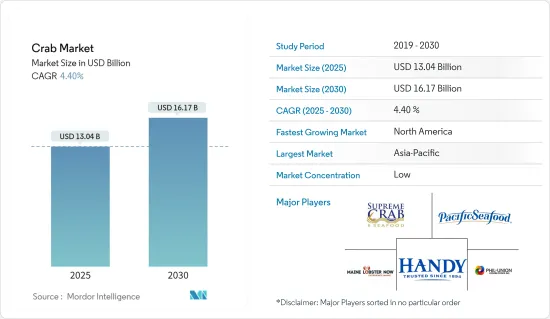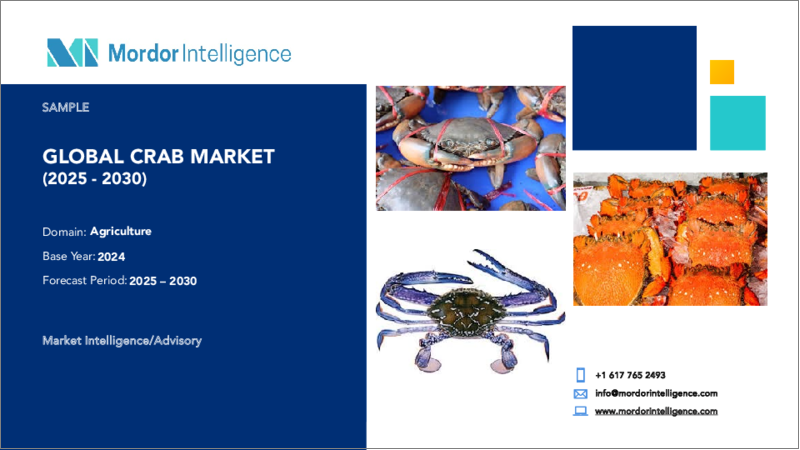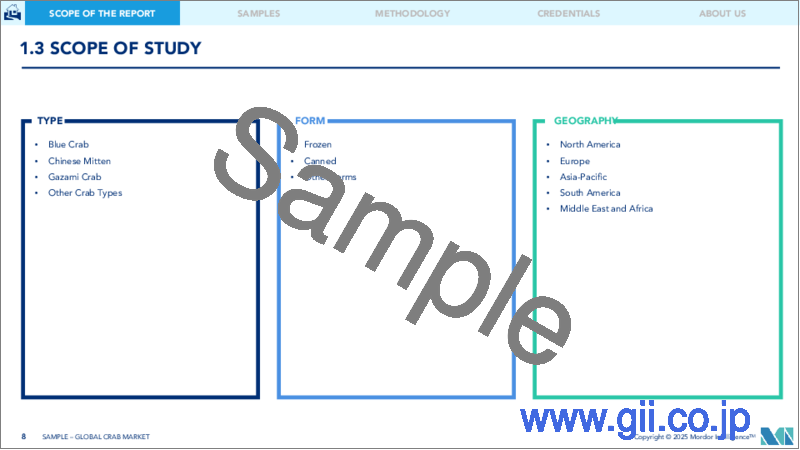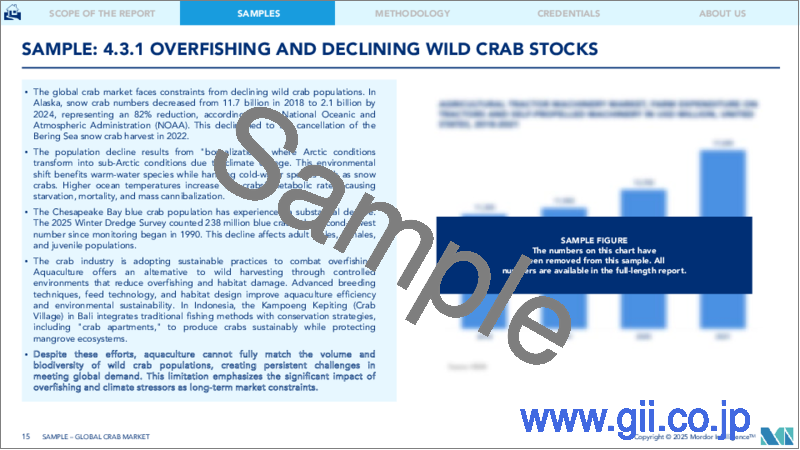|
|
市場調査レポート
商品コード
1689763
カニ-市場シェア分析、産業動向・統計、成長予測(2025~2030年)Crab - Market Share Analysis, Industry Trends & Statistics, Growth Forecasts (2025 - 2030) |
||||||
カスタマイズ可能
適宜更新あり
|
|||||||
| カニ-市場シェア分析、産業動向・統計、成長予測(2025~2030年) |
|
出版日: 2025年03月18日
発行: Mordor Intelligence
ページ情報: 英文 120 Pages
納期: 2~3営業日
|
- 全表示
- 概要
- 目次
2025年のカニ市場規模は130億4,000万米ドルと推定され、予測期間中(2025~2030年)のCAGRは4.4%で、2030年には161億7,000万米ドルに達すると予測されます。

カニは水産物セグメントの甲殻類に属し、世界的に消費される主要な水産物です。タラバガニ、アブラガニ、オピリオ、タナガニなどのカニは、かなりのタンパク質、ビタミン、ミネラルを含んでいます。カニ肉には抗炎症作用があり、血圧を下げ、骨と精神の健康を増進します。このような要因と、カニ肉の健康上の利点に関する意識の高まりが、今後数年間の消費を促進すると予想されます。
さらに、外食産業はカニの主要なエンドユーザーです。外食産業の台頭は世界のカニ市場に直接影響を与えます。世界の外食産業は、新しい技術、イノベーション、メニューのカスタマイズにより、増加しています。また、健康的で栄養価の高い食品への志向やグルテンフリー食への需要の高まりが、市場の成長を支えるものと予想されます。
さらに、冷凍カニは季節に関係なく一年中入手できるため、家庭での需要が高まっています。冷凍カニは、カニケーキ、カニビスク、カニサラダ、カニ詰めキノコなどの軽食を家庭で最小限の調理で調理するのに利用できます。例えば、2023年に韓国が輸入した冷凍カニは3万3,700トンで、2022年の2万6,600トンと比べて26.7%増加しました。
カニ市場の動向
冷凍カニが人気を集める
冷凍カニは通常、獲れたてのカニを洗浄、調理し、品質保持のために冷凍したものです。冷凍することでカニ肉の保存期間が延び、消費者はカニの漁期を過ぎてもカニを楽しむことができます。冷凍カニを生産・輸出する主要国はカナダとロシアです。2023年、カナダは前年比22.4%増の7万3,800トンを輸出したが、これはカナダにおける冷凍カニの需要を反映しています。
ロシアは毎年約10万トンのカニを生産しており、水産業の中でも有利なセグメントです。伝統的に、これらの輸出は主に西側市場、特に欧州連合と米国向けでした。しかし、2022年2月のロシアのウクライナ侵攻とそれに伴う貿易制裁を受け、ロシア産カニの流れはアジア太平洋へと顕著にシフトしました。この地政学的な変化は、カニの貿易ルートを変えただけでなく、需給関係にも大きな影響を与えています。例えば、日本のロシアからの冷凍カニの輸入は、財務省の報告によると、2023年に18%急増し、1万3,079トンに達し、冷凍カニ消費の需要増を反映しています。この輸入の増加は、ロシア産冷凍カニの価格下落に起因しています。
最も急成長している地域の北米
北米はカニ市場で最も急成長している地域であり、世界のカニ市場の総シェアに大きく貢献している地域のひとつです。米国海洋大気庁(NOAA)の報告書によると、水産物の水揚げ量の増加と、健康志向の消費者による輸入カニやその他の水産物の需要の高まりにより、近年アメリカの食生活における水産物の割合が高まっています。以前は、米国はロシア産カニの輸入に頼っていました。しかし、米国政府による2023年5月からの制裁措置により、ロシアの輸入は制限されました。その結果、他の国々が米国市場にカニを供給する機会を得ることになりました。
労働統計局によると、2021年の米国における消費者1人当たりの魚介類への平均支出は729米ドルでした。同様に、Progressive Grocerによると、米国でサステイナブル水産物を求める買い物客の割合は2019~2021年にかけて増加しました。2019年、サステイナブル水産物を求める水産物買い物客は29%に過ぎなかりました。この数字は2021年には41%に達しています。さらに、カナダはズワイガニの世界最大の生産国で、世界供給の約3分の2を供給しています。甘くて風味豊かな身が特徴のズワイガニは、大西洋で獲れる甲殻類の中で最も人気があります。雪のように白い身は風味豊かで、バターをつけて食べる人も多いです。ズワイガニはまた、その風味豊かな身と価格の安さから、家庭やプロの料理人にも人気があります。カナダ漁業海洋省によると、3K漁業におけるズワイガニ全体の漁獲枠は、2022年の9,840トンから2023年には18%増の1万1,591トンとなります。このような水産物消費の増加は、予測期間中のカニ市場の成長を後押しすると予想されます。
カニ産業概要
カニ市場は高度にセグメント化されており、国際企業や地域企業がより高い市場シェアと消費者拡大を目指して競争を激化させています。冷凍と缶のカニの供給と取引に従事している主要企業には、Supreme Crab & Seafood Inc.、Maine Lobster Now、Pacific Sea Food、Handy Sea Food Incorporated、Phil-Union Frozen Foods Inc.などがあります。
市場の主要企業は、市場での地位を維持するため、製品ポートフォリオを拡大し、事業の幅を広げています。様々な組み合わせのカニレシピを市場に投入することで製品ポートフォリオを広げることが、これらの企業が最も採用している戦略です。
その他の特典
- エクセル形式の市場予測(ME)シート
- 3ヶ月間のアナリストサポート
目次
第1章 イントロダクション
- 調査想定と市場定義
- 調査範囲
第2章 調査手法
第3章 エグゼクティブサマリー
第4章 市場力学
- 市場概要
- 市場の促進要因
- カニの栄養的利点に関する意識の高まり
- 水産物消費の増加に伴う輸出の増加
- 政府によるイニシアチブの高まり
- 市場抑制要因
- 消費者の植物性肉志向の高まり
- カニ生産の成長を阻害する気候変動
- ポーターのファイブフォース分析
- 新規参入業者の脅威
- 買い手の交渉力
- 供給企業の交渉力
- 代替品の脅威
- 競争企業間の敵対関係の強さ
第5章 市場セグメンテーション
- タイプ別
- ワタリガニ
- 中国産ミトン
- ガザミ
- その他
- 形態別
- 冷凍
- 缶
- その他の形態
- 地域別
- 北米
- 米国
- カナダ
- メキシコ
- その他の北米
- 欧州
- フランス
- ベルギー
- ドイツ
- オランダ
- 英国
- その他の欧州
- アジア太平洋
- 中国
- インドネシア
- フィリピン
- ベトナム
- インド
- 日本
- オーストラリア
- その他のアジア太平洋
- 南米
- アルゼンチン
- ブラジル
- その他の南米
- 中東・アフリカ
- 南アフリカ
- アラブ首長国連邦
- その他の中東・アフリカ
- 北米
第6章 競合情勢
- 最も採用されている戦略
- 市場シェア分析
- 企業プロファイル
- Supreme Crab & Seafood Inc.
- Maine Lobster Now
- Pacific Seafood
- Handy Sea Food Incorporated
- Phil-Union Frozen Foods Inc.
- JM Clayton Seafood Company
- RGE Agridev Corporation
- Siam Canadian Group Limited
- Handy Seafood
第7章 市場機会と今後の動向
The Crab Market size is estimated at USD 13.04 billion in 2025, and is expected to reach USD 16.17 billion by 2030, at a CAGR of 4.4% during the forecast period (2025-2030).

Crabs come under crustaceans in seafood segments and are one of the major seafood consumed globally. Crabs such as red king crab, blue king crab, opilio, and tanner contain significant protein, vitamin, and mineral content. Crab meat has anti-inflammatory properties that reduce blood pressure and enhance bone and mental health. Such factors and the growing awareness about the health benefits of crab meat are expected to encourage its consumption in the coming years.
Furthermore, the food service industry is the major end-user of crabs. The rise of the food service industry directly affects the global crab market. The food service industry worldwide is multiplying because of new technology, innovations, and customizations in menus. In addition, the inclination toward healthy and nutritious foods and increasing demand for gluten-free diets are expected to support the market's growth.
Moreover, the demand for frozen crabs is rising in households as they are available year-round, irrespective of the season. They can be used to prepare snacks like crab cakes, crab bisque, crab salad, and crab-stuffed mushrooms at home with minimum cooking. For instance, in 2023, South Korea imported 33.7 thousand metric tons of frozen crab, which was 26.7% more compared to 26.6 thousand metric tons in 2022.
Crab Market Trends
Frozen Crab is Gaining Traction
Frozen crab is typically obtained from freshly caught crabs, which are cleaned, cooked, and then frozen to maintain quality. Freezing helps extend the shelf life of crab meat, allowing consumers to enjoy it beyond the crabbing season. The major countries that produce and export frozen crabs are Canada and Russia. In 2023, Canada exported 73.8 thousand metric tons, which was 22.4% more than the previous year, reflecting the demand for frozen crabs in Canada.
Russia annually produces around 100,000 metric tons of crab, a lucrative segment within its fisheries industry. Traditionally, these exports were predominantly bound for Western markets, notably the European Union and the United States. However, following Russia's invasion of Ukraine in February 2022 and the ensuing trade sanctions, the flow of Russian crabs has notably pivoted toward Asia-Pacific. This geopolitical shift has not only altered crab trade routes but has also significantly impacted supply and demand dynamics. For instance, Japan's frozen crab imports from Russia surged by 18% in 2023, reaching 13,079 metric tons, as reported by the Ministry of Finance, reflecting the growing demand for frozen crab consumption. This uptick in imports can be attributed to declining prices of Russian frozen crab.
North America in the Fastest Growing Region
North America is the fastest-growing region in the crab market; it is one of the major contributors to the total share of the crab market globally. According to a report by the National Oceanic and Atmospheric Administration (NOAA), an increase in seafood landings and rising demand for imported crabs and other seafood from health-conscious consumers have raised the share of seafood in American diets in recent years. Previously, the United States relied on Russian crab imports to meet its demand. However, due to sanctions imposed from May 2023 by the US government, Russian imports were restricted. As a result, other countries now have an opportunity to supply crabs to the US market.
According to the Bureau of Labour Statistics, the average expenditure on fish and seafood per consumer unit in the United States in 2021 accounted for USD 729. Similarly, according to Progressive Grocer, the share of seafood shoppers looking for sustainable seafood products in the United States increased from 2019 to 2021. In 2019, only 29% of seafood shoppers sought sustainable seafood. This figure was at 41% in 2021. Further, Canada is the world's largest producer of Snow crab, providing about two-thirds of the global supply. With its sweet, flavorful meat, snow crab is one of the most popular crustaceans from the Atlantic. The delectable, snow-white meat is so flavorful that many people enjoy it sans-dipping butter. Snow crab is also popular with home and professional chefs because of its flavorful meat and low cost. As per Fisheries and Ocean Canada, the overall quota of snow crab in division 3K increased by 18% in 2023 to 11,591 metric tons from 9,840 metric tons in 2022. This increase in seafood consumption is expected to boost the growth of the crab market during the forecast period.
Crab Industry Overview
The crab market is highly fragmented, with international and regional companies intensifying the competition for a higher market share and an extended consumer outreach. Some major companies that have indulged in the supply and trade of frozen and canned crabs include Supreme Crab & Seafood Inc., Maine Lobster Now, Pacific Sea Food, Handy Sea Food Incorporated, and Phil-Union Frozen Foods Inc.
Major players in the market have extended their product portfolio and broadened their business to maintain their position in the market. Broadening the product portfolio by introducing various combinations of crab recipes into the market is the strategy these companies have adopted the most.
Additional Benefits:
- The market estimate (ME) sheet in Excel format
- 3 months of analyst support
TABLE OF CONTENTS
1 INTRODUCTION
- 1.1 Study Assumption and Market Definition
- 1.2 Scope of the Study
2 RESEARCH METHODOLOGY
3 EXECUTIVE SUMMARY
4 MARKET DYNAMICS
- 4.1 Market Overview
- 4.2 Market Drivers
- 4.2.1 Rising Awareness About the Nutritional Benefits of Crabs
- 4.2.2 Growing Exports with the Rise in Seafood Consumption
- 4.2.3 Rising Initiatives by Government
- 4.3 Market Restraints
- 4.3.1 Growing Inclination of Consumers Toward Plant-based Meat
- 4.3.2 Climate Change Impeding the Growth of Crab Production
- 4.4 Porter's Five Forces Analysis
- 4.4.1 Threat of New Entrants
- 4.4.2 Bargaining Power of Buyers
- 4.4.3 Bargaining Power of Suppliers
- 4.4.4 Threat of Substitute Products
- 4.4.5 Intensity of Competitive Rivalry
5 MARKET SEGMENTATION
- 5.1 By Type
- 5.1.1 Blue Crab
- 5.1.2 Chinese Mitten
- 5.1.3 Gazami Crab
- 5.1.4 Other Crab Types
- 5.2 By Form
- 5.2.1 Frozen
- 5.2.2 Canned
- 5.2.3 Other Forms
- 5.3 By Geography
- 5.3.1 North America
- 5.3.1.1 United States
- 5.3.1.2 Canada
- 5.3.1.3 Mexico
- 5.3.1.4 Rest of North America
- 5.3.2 Europe
- 5.3.2.1 France
- 5.3.2.2 Belgium
- 5.3.2.3 Germany
- 5.3.2.4 Netherlands
- 5.3.2.5 United Kingdom
- 5.3.2.6 Rest of Europe
- 5.3.3 Asia-Pacific
- 5.3.3.1 China
- 5.3.3.2 Indonesia
- 5.3.3.3 Philippines
- 5.3.3.4 Vietnam
- 5.3.3.5 India
- 5.3.3.6 Japan
- 5.3.3.7 Australia
- 5.3.3.8 Rest of Asia-Pacific
- 5.3.4 South America
- 5.3.4.1 Argentina
- 5.3.4.2 Brazil
- 5.3.4.3 Rest of South America
- 5.3.5 Middle East and Africa
- 5.3.5.1 South Africa
- 5.3.5.2 United Arab Emirates
- 5.3.5.3 Rest of Middle East and Africa
- 5.3.1 North America
6 COMPETITIVE LANDSCAPE
- 6.1 Most Adopted Strategies
- 6.2 Market Share Analysis
- 6.3 Company Profiles
- 6.3.1 Supreme Crab & Seafood Inc.
- 6.3.2 Maine Lobster Now
- 6.3.3 Pacific Seafood
- 6.3.4 Handy Sea Food Incorporated
- 6.3.5 Phil-Union Frozen Foods Inc.
- 6.3.6 JM Clayton Seafood Company
- 6.3.7 RGE Agridev Corporation
- 6.3.8 Siam Canadian Group Limited
- 6.3.9 Handy Seafood






